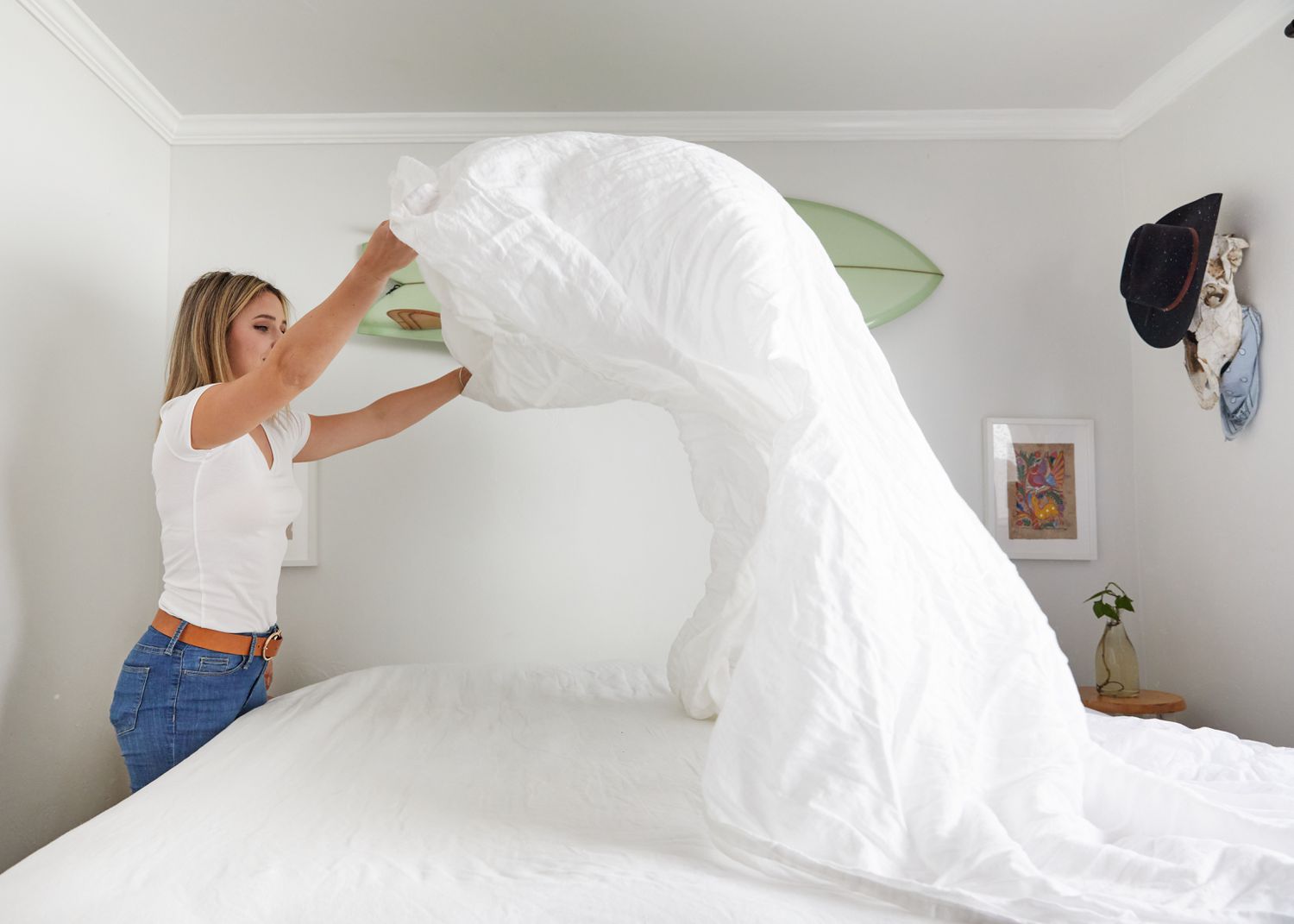Home>Interior Design>Bed-making Mistakes That Affect Your Sleep – And Fast Fixes


Interior Design
Bed-making Mistakes That Affect Your Sleep – And Fast Fixes
Modified: October 20, 2024
Avoid these bed-making mistakes that can impact your sleep and learn quick fixes to improve your sleep quality. Enhance your interior design with these easy tips.
(Many of the links in this article redirect to a specific reviewed product. Your purchase of these products through affiliate links helps to generate commission for Storables.com, at no extra cost. Learn more)
Introduction
Welcome to the world of interior design, where every element plays a crucial role in creating a harmonious and inviting space. From furniture selection to color schemes, every decision matters. However, one often overlooked aspect of interior design that can greatly impact our well-being is the way we make our beds.
We spend approximately one-third of our lives in bed, making it essential to create a comfortable and welcoming environment for quality sleep. The way we make our beds can directly affect the quality of our rest and overall sleep experience. In this article, we will explore common bed-making mistakes that can compromise our sleep and provide fast fixes to remedy them.
So, whether you’re a design enthusiast aiming for a picture-perfect bedroom or simply looking for ways to improve your sleep, this article will guide you through the do’s and don’ts of bed-making.
Key Takeaways:
- Invest in high-quality, breathable sheets to regulate temperature and enhance sleep comfort. Opt for a minimalist approach to pillows to reduce clutter and streamline bedtime routines.
- Ensure a snug fit for the fitted sheet and rotate your mattress regularly for even wear. Choose the correct pillow for your sleep position to maintain proper spinal alignment and improve sleep quality.
Read more: How To Fix E2 Error In A Washing Machine
Mistake #1: Using the wrong type of sheets
When it comes to choosing sheets for your bed, it’s easy to get overwhelmed by the options available. From materials like cotton, linen, and silk to different thread counts, the choices seem endless. However, using the wrong type of sheets can have a significant impact on your sleep quality.
One common mistake is using sheets that are not breathable. Sheets made from synthetic materials like polyester or microfiber can trap heat and moisture, leading to discomfort and night sweats. This can result in a restless sleep and wake up feeling hot and sticky.
Another mistake is selecting the wrong thread count. While a high thread count may seem luxurious, it doesn’t necessarily mean better quality. Sheets with a thread count above 600 can often feel heavy and restrict airflow, making them less breathable. Opting for sheets with a thread count between 300-500 is typically a good balance between comfort and durability.
To avoid this mistake, choose sheets made from natural, breathable materials like cotton or linen. These fabrics allow air to circulate, keeping you cool and comfortable throughout the night. Additionally, look for sheets with a thread count that suits your preferences and climate.
Investing in high-quality sheets that promote airflow and regulate temperature can greatly enhance your sleep experience, ensuring you wake up feeling refreshed and energized each morning.
Mistake #2: Failing to properly stretch the fitted sheet
One of the key components of making a bed is ensuring a properly fitted sheet. Failing to stretch the fitted sheet tightly can lead to a wrinkled, uncomfortable sleeping surface. This can not only affect the overall look of your bed but also impact your sleep quality.
When the fitted sheet is not stretched properly, it can bunch up or come loose during the night, causing discomfort and disturbances. Wrinkled sheets can also be abrasive against your skin, leading to irritation and interrupting your sleep.
To avoid this mistake, start by placing the fitted sheet on your mattress and ensure that all four corners are securely tucked in. Once the corners are in place, pull the sheet tightly across the mattress, smoothing out any wrinkles as you go. This will help create a smooth and taut surface, providing a comfortable foundation for your sleep.
In addition to properly stretching the fitted sheet, consider using sheet fasteners or clips to keep it in place. These handy tools can help prevent the sheet from slipping or coming loose during the night, ensuring you maintain a wrinkle-free and comfortable sleeping surface.
By taking the time to properly stretch your fitted sheet, you’ll not only achieve a polished and neat bed appearance but also create a comfortable sleeping environment that promotes restful sleep.
Mistake #3: Overloading the bed with too many pillows
Pillows are a staple item on any bed, providing support and comfort for a good night’s sleep. However, going overboard with the number of pillows on your bed can hinder your sleep quality and create unnecessary clutter.
While decorative pillows can add a touch of style to your bed, it’s important to strike a balance between aesthetics and functionality. Having an excessive number of pillows can make it difficult to find a comfortable position and create a feeling of being overwhelmed by clutter.
Furthermore, excessive pillows can be time-consuming and cumbersome to remove and rearrange every night when it’s time to sleep. This can create a nightly ritual that prolongs the process of getting into bed and hinders relaxation.
To avoid this mistake, opt for a minimalist approach when it comes to pillows. Choose the number of pillows that provide the necessary support for your sleep position, whether it’s one or two for a single sleeper or a few more for a couple. Keep in mind that the primary purpose of pillows is to support your head, neck, and spine, so prioritize functionality over excessive decoration.
If you love the decorative aspect of pillows, consider incorporating a few well-chosen accent pillows that can easily be removed or placed elsewhere during bedtime. This way, you can enjoy a visually pleasing bed during the day while maintaining a clutter-free and comfortable sleeping environment at night.
By avoiding the temptation to overload your bed with too many pillows, you’ll create a more functional and peaceful sleep space, conducive to restful and rejuvenating sleep.
Mistake #4: Tucking in the sheets too tightly
When making the bed, one common mistake is tucking in the sheets too tightly. While you may think that tightly tucked sheets create a neater and more polished appearance, it can actually have negative effects on your sleep and comfort.
When the sheets are tucked in too tightly, it restricts movement and compromises airflow. This can make you feel confined and claustrophobic during sleep, hindering your ability to find a comfortable position and relax fully. Additionally, tightly tucked sheets can create excess pressure on your body, leading to discomfort and even disrupted sleep.
Furthermore, tightly tucked sheets can cause the sheets to come loose during the night, leading to wrinkling and bunching. This can be frustrating and require readjustment, disturbing your sleep and potentially waking you up.
To avoid this mistake, aim for a balance between having neatly tucked sheets and allowing some freedom and movement. When tucking in the sheets, ensure that they are secure but not overly tight. Leave a bit of space for movement and ensure that you can easily slide in and out of bed without feeling constricted.
By loosening up the sheets, you’ll create a more comfortable and breathable sleep environment, allowing for better airflow and freedom of movement. This will contribute to a more restful and uninterrupted night’s sleep, helping you wake up feeling refreshed and ready to take on the day.
Mistake #5: Neglecting to rotate the mattress
Your mattress is the foundation of a good night’s sleep, and proper maintenance is key to ensuring its longevity and comfort. One common mistake that many people make is neglecting to rotate their mattress regularly.
Over time, mattresses can develop uneven wear and sagging due to the continuous pressure exerted on specific areas of the bed. This can lead to discomfort while sleeping, as well as back and neck pain. By neglecting to rotate the mattress, you are allowing these pressure points to remain in the same position, exacerbating the wear and tear.
Rotating the mattress involves turning it 180 degrees, so the foot of the mattress becomes the head. It can also involve flipping the mattress if it is double-sided. Rotating the mattress helps distribute the weight and pressure evenly, allowing it to wear more evenly and maintain its supportive properties.
The frequency of rotating your mattress depends on the mattress type. Some mattresses may require rotation every three to six months, while others may need it every year. Check the manufacturer’s guidelines for specific recommendations.
By incorporating mattress rotation into your regular bed-making routine, you can extend the lifespan of your mattress and enjoy more even support throughout its lifespan. This will ultimately contribute to better sleep quality and ensure that your investment in a quality mattress lasts for years to come.
Mistake #6: Using the wrong pillow for your sleep position
Choosing the right pillow is crucial for maintaining proper spinal alignment and getting a good night’s sleep. However, one common mistake that people make is using the wrong pillow for their sleep position.
Each sleep position – whether you sleep on your back, stomach, or side – requires a specific type of pillow to provide the necessary support and alignment. Using the wrong pillow can lead to discomfort, strain on the neck and spine, and disrupted sleep.
For back sleepers, a medium-firm pillow that supports the natural curve of the neck is recommended. This helps keep the spine properly aligned and reduces the risk of waking up with aches and pains.
Stomach sleepers, on the other hand, should opt for a softer, flatter pillow. This helps prevent the head and neck from being lifted too high, which can strain the muscles and lead to discomfort.
Side sleepers benefit from a firmer pillow with extra height to fill the gap between the shoulder and neck. This helps keep the head and neck in alignment with the spine, reducing the risk of neck and shoulder pain.
Using the wrong pillow for your sleep position can result in restless nights and contribute to ongoing discomfort and pain. It’s important to invest in a pillow that suits your specific sleep style and supports your unique body alignment.
Take the time to evaluate your sleep position and find a pillow that is tailored to your needs. This can make a significant difference in the quality of your sleep and help you wake up feeling refreshed and free from stiffness or pain.
Mistake #7: Ignoring proper mattress maintenance
A mattress is a significant investment, and proper maintenance is essential to ensure its longevity and performance. However, one common mistake that many people make is ignoring the importance of regular mattress maintenance.
Over time, mattresses can accumulate dust, allergens, and debris, which can affect sleep quality and even the overall lifespan of the mattress. Neglecting to clean and care for your mattress can lead to issues such as odors, mold growth, and decreased comfort.
To avoid this mistake, establish a regular maintenance routine for your mattress. This should include regular vacuuming to remove dust and debris from the surface and crevices. You can also use baking soda to freshen up the mattress by sprinkling it on the surface and letting it sit for a few hours before vacuuming it off.
It’s also important to protect your mattress from spills and stains by using a mattress protector or cover. This will help prevent liquids and other substances from seeping into the mattress, allowing for easier cleaning and maintenance.
In addition to regular cleaning, it’s crucial to follow the manufacturer’s guidelines for rotating and flipping the mattress, if applicable. This helps ensure even wear and maintains the mattress’s supportive properties over time.
Another aspect of mattress maintenance is addressing any issues promptly. If you notice sagging or discomfort, it’s essential to assess whether it’s time to replace your mattress or consider using a mattress topper for added comfort and support.
By giving your mattress the attention it deserves through regular maintenance, you can extend its lifespan, enhance sleep quality, and protect your investment. A well-maintained mattress will provide a comfortable and supportive surface for a restful night’s sleep for years to come.
When making your bed, be sure to smooth out any wrinkles in the sheets and blankets to prevent discomfort while sleeping. This simple step can make a big difference in the quality of your sleep.
Fast Fix #1: Invest in high-quality, breathable sheets
When it comes to optimizing your bed for a better night’s sleep, one fast fix is to invest in high-quality, breathable sheets. The type of sheets you use can have a significant impact on your sleep comfort and overall experience.
High-quality sheets made from natural materials like cotton or linen offer several benefits. Firstly, these materials are breathable, allowing air to circulate and prevent overheating during the night. This helps regulate your body temperature and promotes a more comfortable sleep environment.
Additionally, natural fibers like cotton and linen are known for their moisture-wicking properties. They can absorb and wick away moisture, keeping you dry and comfortable throughout the night. This is especially important for those prone to night sweats or living in humid climates.
Investing in high-quality sheets also means they are durable and long-lasting. They are less likely to tear or pill, ensuring that your investment will stand the test of time. This means you won’t have to replace your sheets as frequently, saving you money in the long run.
When shopping for sheets, look for options with a thread count between 300-500. This range tends to offer a good balance between comfort, breathability, and durability. It’s important to note that a higher thread count doesn’t always equate to better quality, as sheets with extremely high thread counts can feel heavy and less breathable.
By investing in high-quality, breathable sheets, you’ll create a more comfortable and inviting sleep environment. Your sheets will help regulate your body temperature, reduce moisture build-up, and enhance the overall sleep experience. You’ll wake up feeling refreshed and ready to face the day ahead.
Fast Fix #2: Ensure a snug fit for the fitted sheet
One fast fix to improve your bed-making technique and optimize your sleep experience is to ensure a snug fit for the fitted sheet. A properly fitted sheet not only enhances the neatness and appearance of your bed but also contributes to your overall comfort and quality of sleep.
Start by selecting a fitted sheet that is the appropriate size for your mattress. It should have deep pockets or elasticized corners to ensure a secure fit. A sheet that is too small will constantly come loose, leading to wrinkling and discomfort during the night.
When placing the fitted sheet on your mattress, make sure to tuck in all four corners securely. A common mistake is not fully stretching and securing the corners, which can lead to the sheet slipping off or bunching up during sleep.
Once the corners are secure, gently pull the sheet taut across the mattress, smoothing out any wrinkles or folds along the way. This will help create a flat, even surface for you to sleep on.
Keep in mind that the fitted sheet should have a snug fit without being overly tight. It should be taut enough to stay in place, but not so tight that it restricts movement or causes discomfort.
For added security and to minimize the chances of the sheet slipping off, consider using sheet fasteners or clips. These handy devices can be attached to the corners of the fitted sheet, keeping it firmly in place throughout the night.
By ensuring a snug fit for the fitted sheet, you’ll create a more secure and comfortable sleep surface. The sheet will stay in place, preventing any disturbances or discomfort caused by loose or wrinkled fabric. This fast fix will contribute to better sleep quality and a more enjoyable overall sleep experience.
Fast Fix #3: Opt for a minimalist approach when it comes to pillows
When it comes to pillows, less is often more. Opting for a minimalist approach can be a fast fix to improve your bed-making and sleep experience. Too many pillows on the bed can create unnecessary clutter and impact your sleep quality.
Start by assessing your sleep needs and preferences. Consider the number of pillows that provide the necessary support for your sleep position. For most people, one or two pillows are sufficient for a comfortable night’s sleep. However, this may vary depending on your personal comfort preferences and any specific health considerations.
Avoid the temptation to decorate your bed with excessive decorative pillows. While they may add visual appeal during the daytime, they only serve as obstacles when it’s time to sleep. Having to remove and rearrange numerous pillows every night can be time-consuming and disrupt your relaxation process.
By adopting a minimalist approach to pillows, you not only declutter your sleeping space but also streamline your bedtime routine. You can quickly and effortlessly get into bed and find a comfortable position without the extra hassle. This helps promote a sense of calm and relaxation as you prepare for sleep.
Remember, the primary purpose of a pillow is to support your head, neck, and spine during sleep. It’s important to select a pillow that is suited to your sleep style and provides adequate support. Focus on choosing a high-quality pillow that offers the right level of comfort and support for your individual needs.
By implementing this fast fix and embracing the minimalist approach to pillows, you create a clean and clutter-free sleep environment that promotes a peaceful night’s rest. You’ll be able to enjoy a more streamlined bed-making routine and a calmer atmosphere conducive to a better sleep experience.
Fast Fix #4: Allow some freedom and loosen up the sheets
Creating a comfortable and inviting bed goes beyond just making it look visually appealing. It’s important to ensure that the sheets are not overly tight and allow for some freedom of movement. Allowing the sheets to loosen up can be a fast fix to improve your sleep quality and overall comfort.
When making the bed, it’s common to tuck in the sheets tightly to create a crisp and neat appearance. However, tightly tucked sheets can restrict movement and even create an uncomfortable, constricted feeling while you sleep.
Loosening up the sheets not only allows for more freedom of movement but also promotes better airflow and breathability. When the sheets are tightly tucked, it can trap heat and moisture, leading to discomfort and night sweats. Allowing the sheets to have some slack allows for better air circulation, helping regulate your body temperature throughout the night.
To incorporate this fast fix, start by tucking in the sheets securely at the corners of the mattress. However, when pulling the sheets across the mattress, avoid pulling them excessively tight. Instead, leave a bit of slack and allow the fabric to drape naturally. This will create a relaxed and comfortable surface for you to sleep on.
By allowing some freedom and loosening up the sheets, you’ll reduce the feeling of being confined and enhance your ability to find a comfortable position. This can have a positive impact on your sleep quality, helping you drift off into a more restful and uninterrupted slumber.
Remember, the goal is to strike a balance between a neatly made bed and a comfortable sleep environment. Embracing a less restrictive approach to sheet tightness will contribute to a more relaxed and cozy sleep experience.
Fast Fix #5: Rotate your mattress regularly for even wear
Your mattress is a key component of a good night’s sleep, and regular maintenance is crucial to ensure its longevity and performance. One fast fix that can greatly benefit your mattress is to rotate it regularly for even wear.
Over time, mattresses can develop areas of uneven wear and sagging due to the continuous pressure exerted on specific spots. This can lead to discomfort and even disrupt your sleep. By neglecting to rotate the mattress, you are allowing these pressure points to remain in the same position, which can worsen the wear and tear.
To counter this, make it a habit to rotate your mattress regularly. This involves turning it 180 degrees, so the foot of the mattress becomes the head. If your mattress is double-sided, flipping it can also help distribute the wear evenly.
By rotating the mattress, you ensure that different areas bear the weight and pressure over time. This helps prevent excessive wear and maintains the supportive properties of the mattress. It can also help prolong its lifespan, saving you money in the long run.
The frequency of mattress rotation depends on the type of mattress you have. Some mattresses may require rotation every three to six months, while others may need it yearly. Check the manufacturer’s guidelines or consult the mattress manufacturer for specific recommendations.
When rotating your mattress, take the opportunity to also clean the surface and vacuum any accumulated dust or debris. This will help keep your mattress fresh and hygienic, contributing to a healthier sleep environment.
By incorporating regular mattress rotation into your bed-making routine, you’ll enjoy a more evenly worn mattress. This promotes better support, reduces discomfort, and enhances your overall sleep quality. The effort is minimal, but the benefits are substantial, ensuring that you have a comfortable and restful night’s sleep.
Fast Fix #6: Choose the correct pillow for your preferred sleep position
When it comes to optimizing your sleep experience, one fast fix that can make a significant difference is choosing the correct pillow for your preferred sleep position. The right pillow provides proper support for your head, neck, and spine, ensuring a comfortable and restful night’s sleep.
The ideal pillow will vary depending on whether you sleep on your back, stomach, or side. Each sleep position requires different levels of support to maintain proper spinal alignment and reduce the risk of discomfort and pain.
For back sleepers, a medium-firm pillow is generally recommended. This type of pillow provides enough support to cradle the curve of the neck and keep the spine aligned in a neutral position. It helps prevent excessive neck strain and reduces the risk of waking up with aches and pains.
Stomach sleepers, on the other hand, may benefit from a softer, flatter pillow. This type of pillow prevents the head and neck from being lifted too high, which can strain the muscles and lead to discomfort. A thin and soft pillow helps maintain a more natural alignment for stomach sleepers.
Side sleepers should opt for a firmer pillow with extra height to fill the gap between the shoulder and neck. This helps keep the head and neck aligned with the spine, preventing any unnecessary strain on these areas. Side sleepers may also consider using a body pillow to provide support along the length of the body.
When selecting a pillow, it’s essential to consider your personal preferences along with your sleep position. Factors such as pillow material, loft, and shape can also contribute to your comfort. Experiment with different options and find the one that suits you best.
By choosing the correct pillow for your preferred sleep position, you’ll optimize your comfort and ensure proper spinal alignment. This can lead to better sleep quality, reduced discomfort, and waking up feeling refreshed and rejuvenated.
Fast Fix #7: Follow the manufacturer’s guidelines for mattress care
To prolong the lifespan and maintain the performance of your mattress, it’s important to follow the manufacturer’s guidelines for mattress care. The manufacturer’s recommendations are specifically designed to help you keep your mattress in optimal condition, ensuring a comfortable and supportive sleep surface for years to come.
Each mattress type (such as memory foam, innerspring, latex, etc.) may have specific care instructions. These guidelines typically include recommendations for cleaning, rotating, and protecting the mattress.
One key aspect is regular cleaning. Dust, allergens, and debris can accumulate on the surface of the mattress over time, impacting its hygiene and potentially leading to discomfort and allergies. Follow the manufacturer’s guidelines for cleaning, which may involve vacuuming, spot-cleaning, or using specific cleaning products. Avoid using excessive moisture, as it can damage the mattress components.
Another important aspect is rotating and/or flipping the mattress. Some mattresses may only require rotation, while others may need to be flipped as well. This helps distribute the weight evenly and reduces the risk of uneven wear and sagging. Follow the recommended frequency and technique for rotating/flipping, as outlined by the manufacturer.
The manufacturer may also advise on proper mattress protection. Using a mattress protector or cover can help shield the mattress from spills, stains, dust mites, and allergens. This barrier not only keeps your mattress cleaner, but it also adds a layer of protection against wear and tear, preserving its quality over time.
It’s worth noting that failing to follow the manufacturer’s guidelines for mattress care may void any warranty or guarantee associated with the product. By adhering to these instructions, you can ensure that your mattress remains in good condition and fully benefits from any warranty coverage.
Additionally, if you encounter any issues or concerns with your mattress, such as sagging, uneven wear, or discomfort, it’s important to reach out to the manufacturer or retailer for assistance. They can provide guidance or address any potential warranty claims.
By following the manufacturer’s guidelines for mattress care, you’ll maximize the lifespan and performance of your mattress. This fast fix ensures that your investment in a quality mattress remains in top condition, providing you with the best possible sleep experience for years to come.
Conclusion
Making your bed is not just about creating a visually appealing space – it’s an opportunity to optimize your sleep experience. By avoiding common bed-making mistakes and implementing fast fixes, you can create a comfortable and inviting sleep sanctuary that promotes restful and rejuvenating sleep.
We explored several bed-making mistakes that can affect your sleep, from using the wrong type of sheets to neglecting proper mattress maintenance. However, with the fast fixes provided, you can easily overcome these challenges and enhance your sleep environment.
Investing in high-quality, breathable sheets ensures better airflow and temperature regulation. Ensuring a snug fit for the fitted sheet creates a neat and secure sleeping surface. Adopting a minimalist approach to pillows reduces clutter and enhances comfort. Allowing for some freedom and loosening up the sheets promotes airflow and movement. Remembering to rotate your mattress regularly distributes wear evenly and extends its lifespan. Choosing the correct pillow for your sleep position maintains proper spinal alignment. Following the manufacturer’s guidelines for mattress care ensures long-term performance and warranty coverage.
By incorporating these fast fixes into your bed-making routine, you’ll create a sleep oasis that supports your comfort, health, and overall well-being. You’ll enjoy better sleep quality, waking up feeling refreshed, and ready to take on the day.
So, the next time you make your bed, consider these tips and let your sleep environment work for you. Remember, a well-made bed is not just for appearances – it’s the foundation for a restful and restorative night’s sleep.
Frequently Asked Questions about Bed-making Mistakes That Affect Your Sleep – And Fast Fixes
Was this page helpful?
At Storables.com, we guarantee accurate and reliable information. Our content, validated by Expert Board Contributors, is crafted following stringent Editorial Policies. We're committed to providing you with well-researched, expert-backed insights for all your informational needs.













0 thoughts on “Bed-making Mistakes That Affect Your Sleep – And Fast Fixes”